Financial Analysis: Managing Resources and Decisions Report (Finance)
VerifiedAdded on 2020/02/24
|25
|4708
|76
Report
AI Summary
This report delves into the critical aspects of financial management, exploring various sources of finance available to businesses, including unincorporated and incorporated business structures. It analyzes the implications of using internal and external sources of finance, emphasizing the importance of selecting appropriate financing methods. The report covers cost analysis of different financing options, highlighting the significance of financial planning for a company. It also examines decision-making processes related to takeovers, including the information required by partners and venture capitalists, and assesses the impact of financing on financial statements. Furthermore, the report includes a cash budget, unit cost computation, and an appraisal of investment alternatives, along with a discussion of key financial statement components and ratio analysis, providing a comprehensive overview of financial decision-making and resource management.
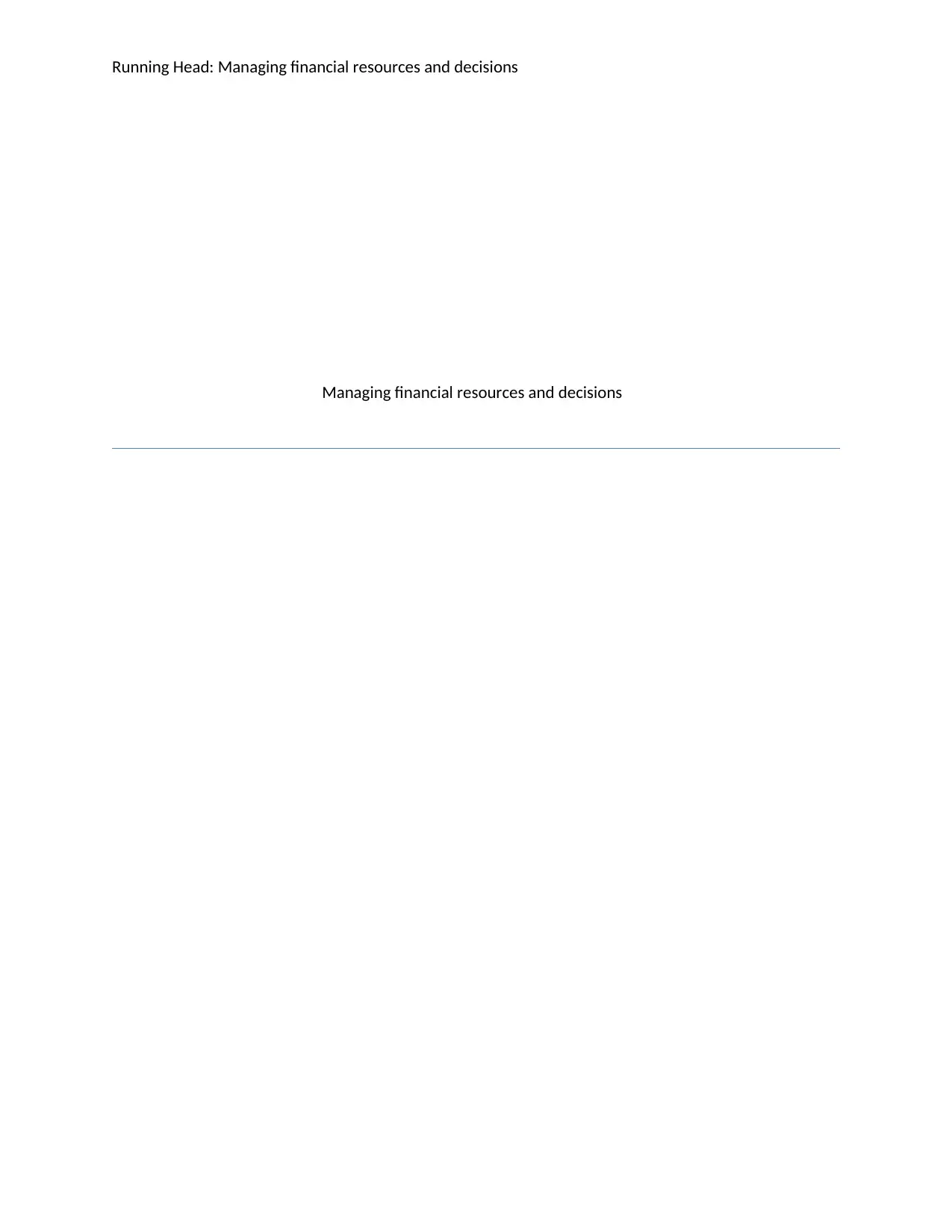
Running Head: Managing financial resources and decisions
Managing financial resources and decisions
Managing financial resources and decisions
Paraphrase This Document
Need a fresh take? Get an instant paraphrase of this document with our AI Paraphraser
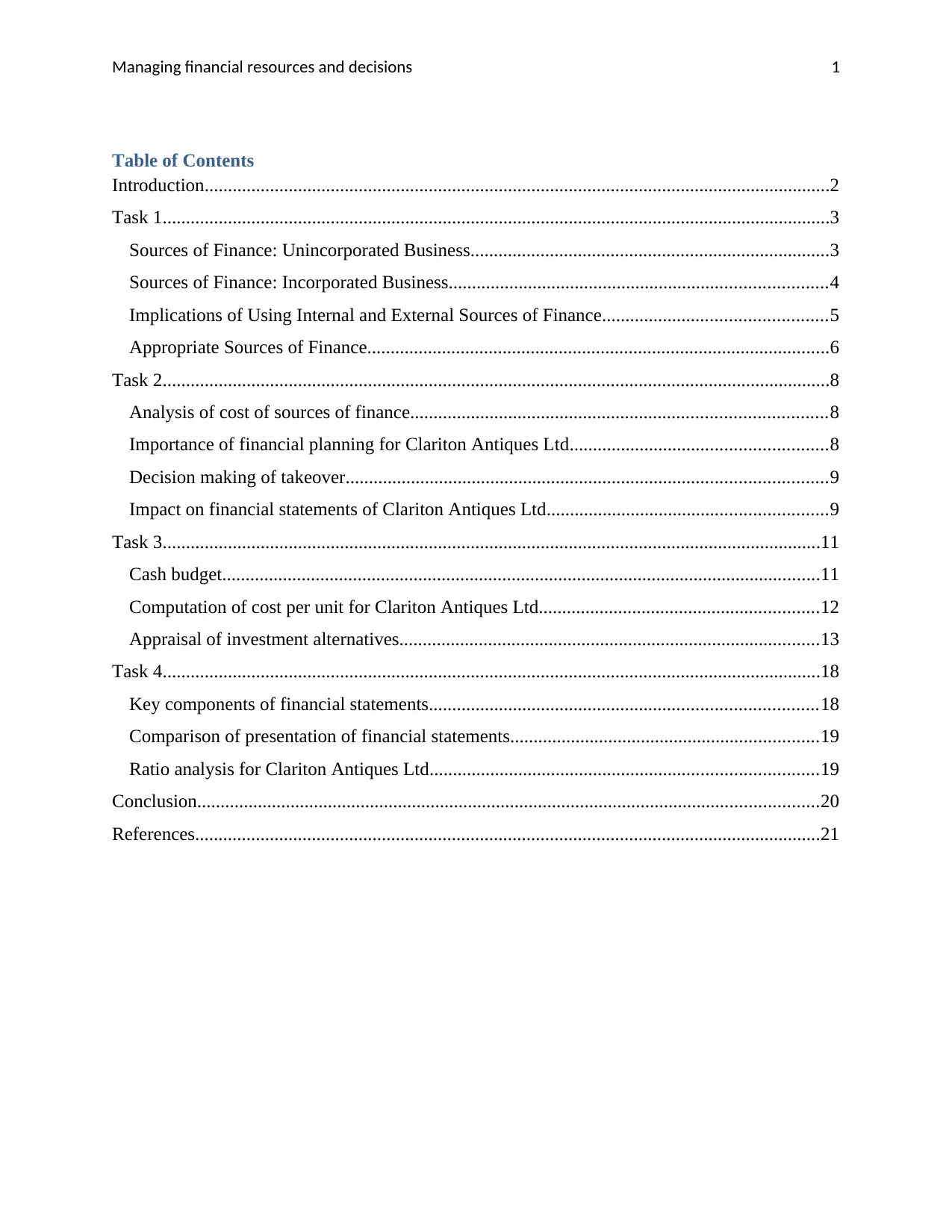
Managing financial resources and decisions 1
Table of Contents
Introduction......................................................................................................................................2
Task 1...............................................................................................................................................3
Sources of Finance: Unincorporated Business.............................................................................3
Sources of Finance: Incorporated Business.................................................................................4
Implications of Using Internal and External Sources of Finance................................................5
Appropriate Sources of Finance...................................................................................................6
Task 2...............................................................................................................................................8
Analysis of cost of sources of finance.........................................................................................8
Importance of financial planning for Clariton Antiques Ltd.......................................................8
Decision making of takeover.......................................................................................................9
Impact on financial statements of Clariton Antiques Ltd............................................................9
Task 3.............................................................................................................................................11
Cash budget................................................................................................................................11
Computation of cost per unit for Clariton Antiques Ltd............................................................12
Appraisal of investment alternatives..........................................................................................13
Task 4.............................................................................................................................................18
Key components of financial statements...................................................................................18
Comparison of presentation of financial statements..................................................................19
Ratio analysis for Clariton Antiques Ltd...................................................................................19
Conclusion.....................................................................................................................................20
References......................................................................................................................................21
Table of Contents
Introduction......................................................................................................................................2
Task 1...............................................................................................................................................3
Sources of Finance: Unincorporated Business.............................................................................3
Sources of Finance: Incorporated Business.................................................................................4
Implications of Using Internal and External Sources of Finance................................................5
Appropriate Sources of Finance...................................................................................................6
Task 2...............................................................................................................................................8
Analysis of cost of sources of finance.........................................................................................8
Importance of financial planning for Clariton Antiques Ltd.......................................................8
Decision making of takeover.......................................................................................................9
Impact on financial statements of Clariton Antiques Ltd............................................................9
Task 3.............................................................................................................................................11
Cash budget................................................................................................................................11
Computation of cost per unit for Clariton Antiques Ltd............................................................12
Appraisal of investment alternatives..........................................................................................13
Task 4.............................................................................................................................................18
Key components of financial statements...................................................................................18
Comparison of presentation of financial statements..................................................................19
Ratio analysis for Clariton Antiques Ltd...................................................................................19
Conclusion.....................................................................................................................................20
References......................................................................................................................................21
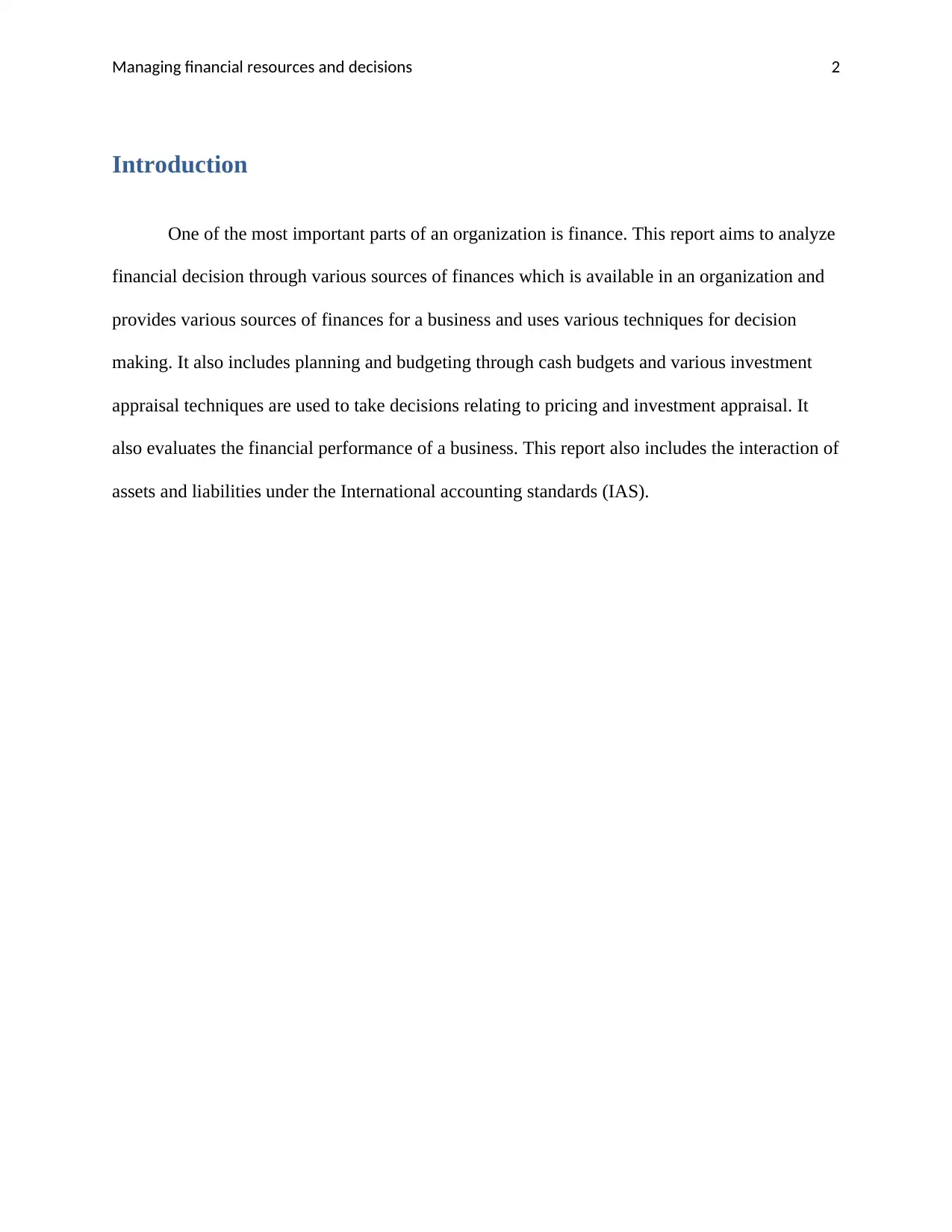
Managing financial resources and decisions 2
Introduction
One of the most important parts of an organization is finance. This report aims to analyze
financial decision through various sources of finances which is available in an organization and
provides various sources of finances for a business and uses various techniques for decision
making. It also includes planning and budgeting through cash budgets and various investment
appraisal techniques are used to take decisions relating to pricing and investment appraisal. It
also evaluates the financial performance of a business. This report also includes the interaction of
assets and liabilities under the International accounting standards (IAS).
Introduction
One of the most important parts of an organization is finance. This report aims to analyze
financial decision through various sources of finances which is available in an organization and
provides various sources of finances for a business and uses various techniques for decision
making. It also includes planning and budgeting through cash budgets and various investment
appraisal techniques are used to take decisions relating to pricing and investment appraisal. It
also evaluates the financial performance of a business. This report also includes the interaction of
assets and liabilities under the International accounting standards (IAS).
⊘ This is a preview!⊘
Do you want full access?
Subscribe today to unlock all pages.

Trusted by 1+ million students worldwide
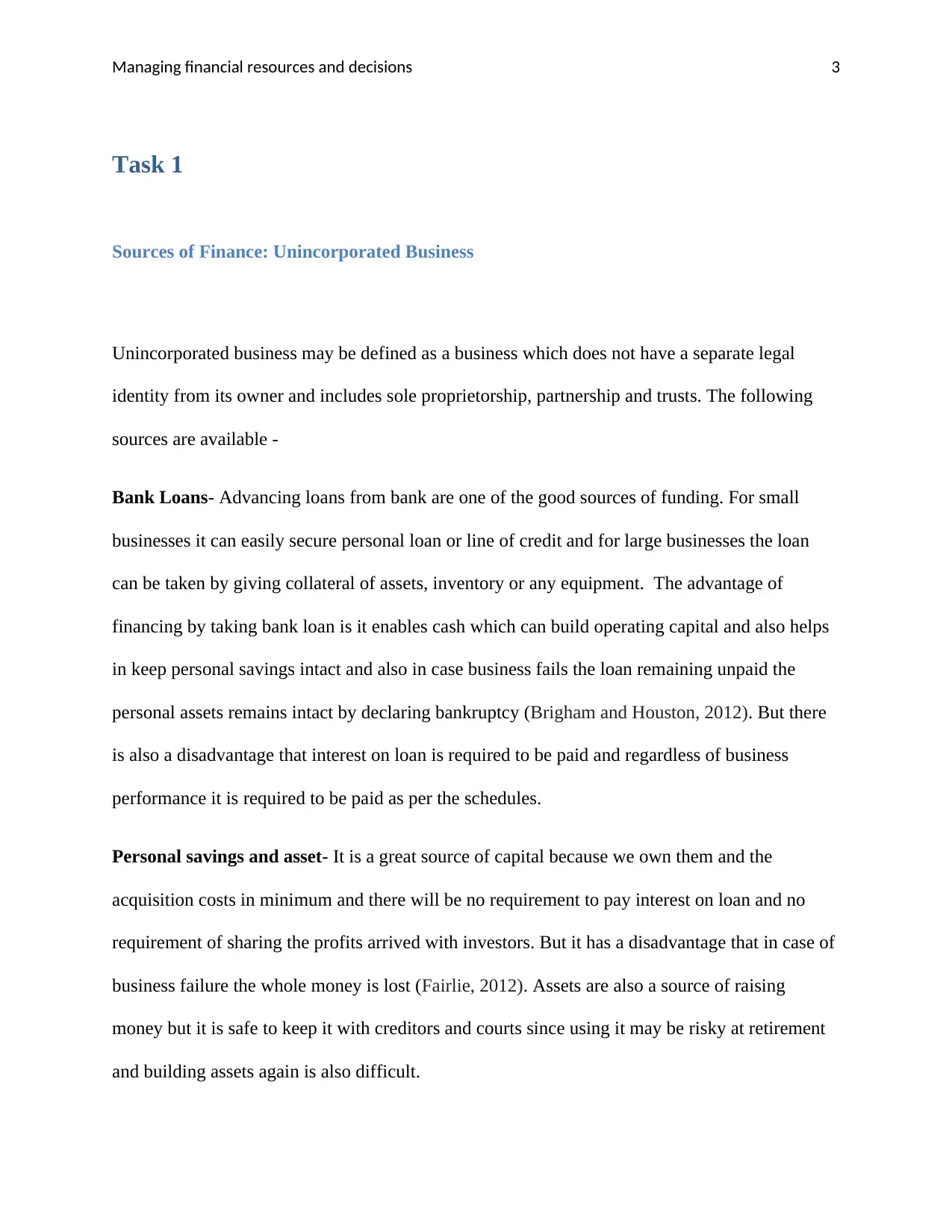
Managing financial resources and decisions 3
Task 1
Sources of Finance: Unincorporated Business
Unincorporated business may be defined as a business which does not have a separate legal
identity from its owner and includes sole proprietorship, partnership and trusts. The following
sources are available -
Bank Loans- Advancing loans from bank are one of the good sources of funding. For small
businesses it can easily secure personal loan or line of credit and for large businesses the loan
can be taken by giving collateral of assets, inventory or any equipment. The advantage of
financing by taking bank loan is it enables cash which can build operating capital and also helps
in keep personal savings intact and also in case business fails the loan remaining unpaid the
personal assets remains intact by declaring bankruptcy (Brigham and Houston, 2012). But there
is also a disadvantage that interest on loan is required to be paid and regardless of business
performance it is required to be paid as per the schedules.
Personal savings and asset- It is a great source of capital because we own them and the
acquisition costs in minimum and there will be no requirement to pay interest on loan and no
requirement of sharing the profits arrived with investors. But it has a disadvantage that in case of
business failure the whole money is lost (Fairlie, 2012). Assets are also a source of raising
money but it is safe to keep it with creditors and courts since using it may be risky at retirement
and building assets again is also difficult.
Task 1
Sources of Finance: Unincorporated Business
Unincorporated business may be defined as a business which does not have a separate legal
identity from its owner and includes sole proprietorship, partnership and trusts. The following
sources are available -
Bank Loans- Advancing loans from bank are one of the good sources of funding. For small
businesses it can easily secure personal loan or line of credit and for large businesses the loan
can be taken by giving collateral of assets, inventory or any equipment. The advantage of
financing by taking bank loan is it enables cash which can build operating capital and also helps
in keep personal savings intact and also in case business fails the loan remaining unpaid the
personal assets remains intact by declaring bankruptcy (Brigham and Houston, 2012). But there
is also a disadvantage that interest on loan is required to be paid and regardless of business
performance it is required to be paid as per the schedules.
Personal savings and asset- It is a great source of capital because we own them and the
acquisition costs in minimum and there will be no requirement to pay interest on loan and no
requirement of sharing the profits arrived with investors. But it has a disadvantage that in case of
business failure the whole money is lost (Fairlie, 2012). Assets are also a source of raising
money but it is safe to keep it with creditors and courts since using it may be risky at retirement
and building assets again is also difficult.
Paraphrase This Document
Need a fresh take? Get an instant paraphrase of this document with our AI Paraphraser
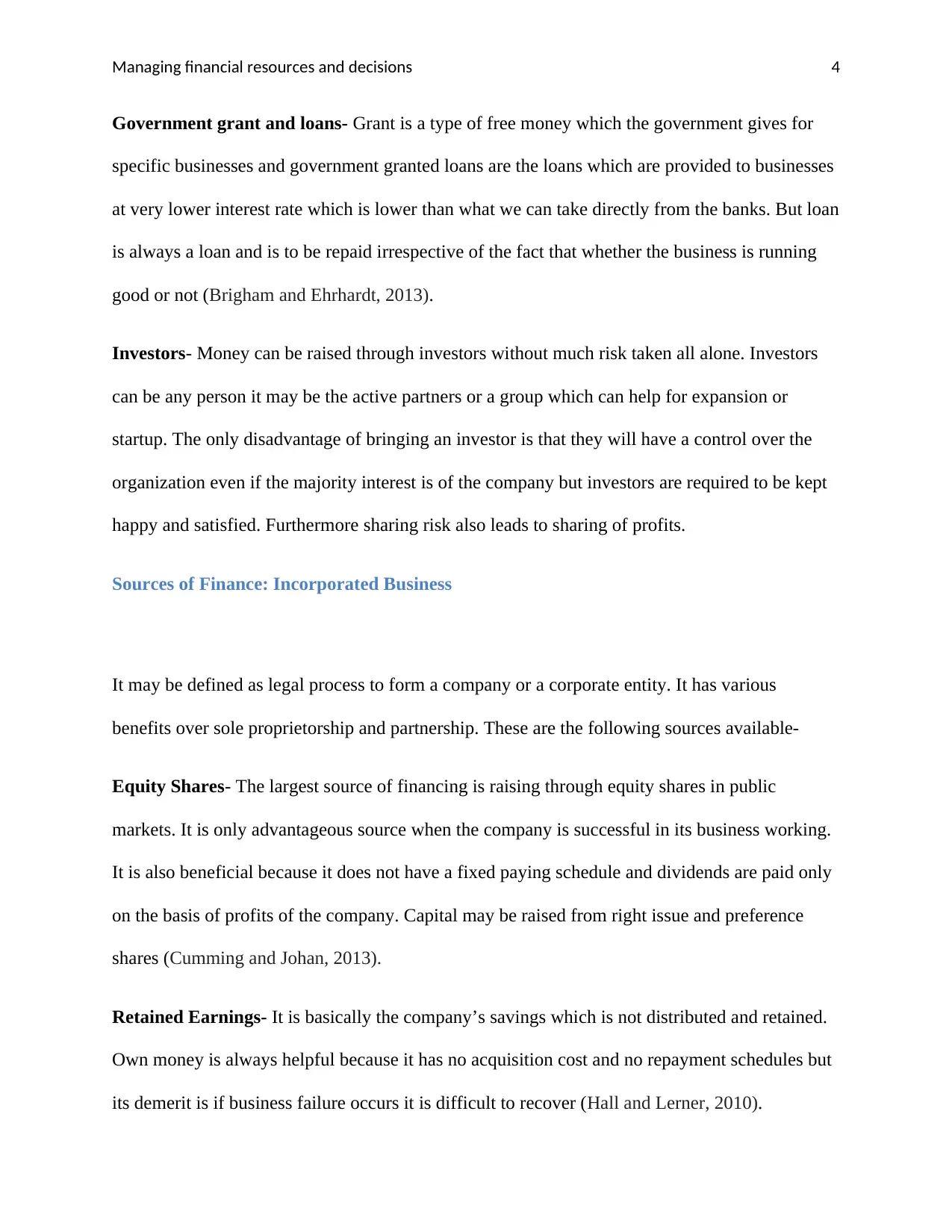
Managing financial resources and decisions 4
Government grant and loans- Grant is a type of free money which the government gives for
specific businesses and government granted loans are the loans which are provided to businesses
at very lower interest rate which is lower than what we can take directly from the banks. But loan
is always a loan and is to be repaid irrespective of the fact that whether the business is running
good or not (Brigham and Ehrhardt, 2013).
Investors- Money can be raised through investors without much risk taken all alone. Investors
can be any person it may be the active partners or a group which can help for expansion or
startup. The only disadvantage of bringing an investor is that they will have a control over the
organization even if the majority interest is of the company but investors are required to be kept
happy and satisfied. Furthermore sharing risk also leads to sharing of profits.
Sources of Finance: Incorporated Business
It may be defined as legal process to form a company or a corporate entity. It has various
benefits over sole proprietorship and partnership. These are the following sources available-
Equity Shares- The largest source of financing is raising through equity shares in public
markets. It is only advantageous source when the company is successful in its business working.
It is also beneficial because it does not have a fixed paying schedule and dividends are paid only
on the basis of profits of the company. Capital may be raised from right issue and preference
shares (Cumming and Johan, 2013).
Retained Earnings- It is basically the company’s savings which is not distributed and retained.
Own money is always helpful because it has no acquisition cost and no repayment schedules but
its demerit is if business failure occurs it is difficult to recover (Hall and Lerner, 2010).
Government grant and loans- Grant is a type of free money which the government gives for
specific businesses and government granted loans are the loans which are provided to businesses
at very lower interest rate which is lower than what we can take directly from the banks. But loan
is always a loan and is to be repaid irrespective of the fact that whether the business is running
good or not (Brigham and Ehrhardt, 2013).
Investors- Money can be raised through investors without much risk taken all alone. Investors
can be any person it may be the active partners or a group which can help for expansion or
startup. The only disadvantage of bringing an investor is that they will have a control over the
organization even if the majority interest is of the company but investors are required to be kept
happy and satisfied. Furthermore sharing risk also leads to sharing of profits.
Sources of Finance: Incorporated Business
It may be defined as legal process to form a company or a corporate entity. It has various
benefits over sole proprietorship and partnership. These are the following sources available-
Equity Shares- The largest source of financing is raising through equity shares in public
markets. It is only advantageous source when the company is successful in its business working.
It is also beneficial because it does not have a fixed paying schedule and dividends are paid only
on the basis of profits of the company. Capital may be raised from right issue and preference
shares (Cumming and Johan, 2013).
Retained Earnings- It is basically the company’s savings which is not distributed and retained.
Own money is always helpful because it has no acquisition cost and no repayment schedules but
its demerit is if business failure occurs it is difficult to recover (Hall and Lerner, 2010).
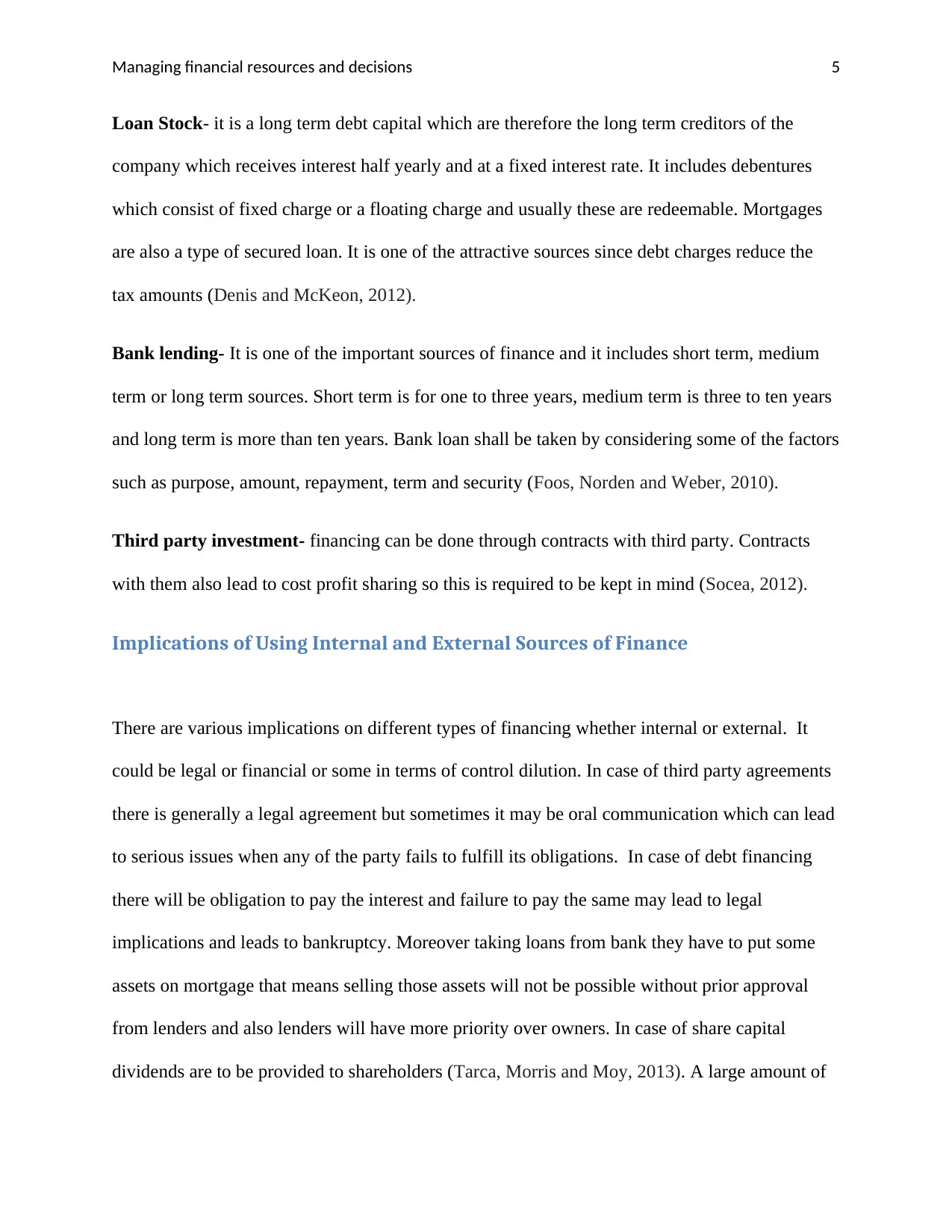
Managing financial resources and decisions 5
Loan Stock- it is a long term debt capital which are therefore the long term creditors of the
company which receives interest half yearly and at a fixed interest rate. It includes debentures
which consist of fixed charge or a floating charge and usually these are redeemable. Mortgages
are also a type of secured loan. It is one of the attractive sources since debt charges reduce the
tax amounts (Denis and McKeon, 2012).
Bank lending- It is one of the important sources of finance and it includes short term, medium
term or long term sources. Short term is for one to three years, medium term is three to ten years
and long term is more than ten years. Bank loan shall be taken by considering some of the factors
such as purpose, amount, repayment, term and security (Foos, Norden and Weber, 2010).
Third party investment- financing can be done through contracts with third party. Contracts
with them also lead to cost profit sharing so this is required to be kept in mind (Socea, 2012).
Implications of Using Internal and External Sources of Finance
There are various implications on different types of financing whether internal or external. It
could be legal or financial or some in terms of control dilution. In case of third party agreements
there is generally a legal agreement but sometimes it may be oral communication which can lead
to serious issues when any of the party fails to fulfill its obligations. In case of debt financing
there will be obligation to pay the interest and failure to pay the same may lead to legal
implications and leads to bankruptcy. Moreover taking loans from bank they have to put some
assets on mortgage that means selling those assets will not be possible without prior approval
from lenders and also lenders will have more priority over owners. In case of share capital
dividends are to be provided to shareholders (Tarca, Morris and Moy, 2013). A large amount of
Loan Stock- it is a long term debt capital which are therefore the long term creditors of the
company which receives interest half yearly and at a fixed interest rate. It includes debentures
which consist of fixed charge or a floating charge and usually these are redeemable. Mortgages
are also a type of secured loan. It is one of the attractive sources since debt charges reduce the
tax amounts (Denis and McKeon, 2012).
Bank lending- It is one of the important sources of finance and it includes short term, medium
term or long term sources. Short term is for one to three years, medium term is three to ten years
and long term is more than ten years. Bank loan shall be taken by considering some of the factors
such as purpose, amount, repayment, term and security (Foos, Norden and Weber, 2010).
Third party investment- financing can be done through contracts with third party. Contracts
with them also lead to cost profit sharing so this is required to be kept in mind (Socea, 2012).
Implications of Using Internal and External Sources of Finance
There are various implications on different types of financing whether internal or external. It
could be legal or financial or some in terms of control dilution. In case of third party agreements
there is generally a legal agreement but sometimes it may be oral communication which can lead
to serious issues when any of the party fails to fulfill its obligations. In case of debt financing
there will be obligation to pay the interest and failure to pay the same may lead to legal
implications and leads to bankruptcy. Moreover taking loans from bank they have to put some
assets on mortgage that means selling those assets will not be possible without prior approval
from lenders and also lenders will have more priority over owners. In case of share capital
dividends are to be provided to shareholders (Tarca, Morris and Moy, 2013). A large amount of
⊘ This is a preview!⊘
Do you want full access?
Subscribe today to unlock all pages.

Trusted by 1+ million students worldwide
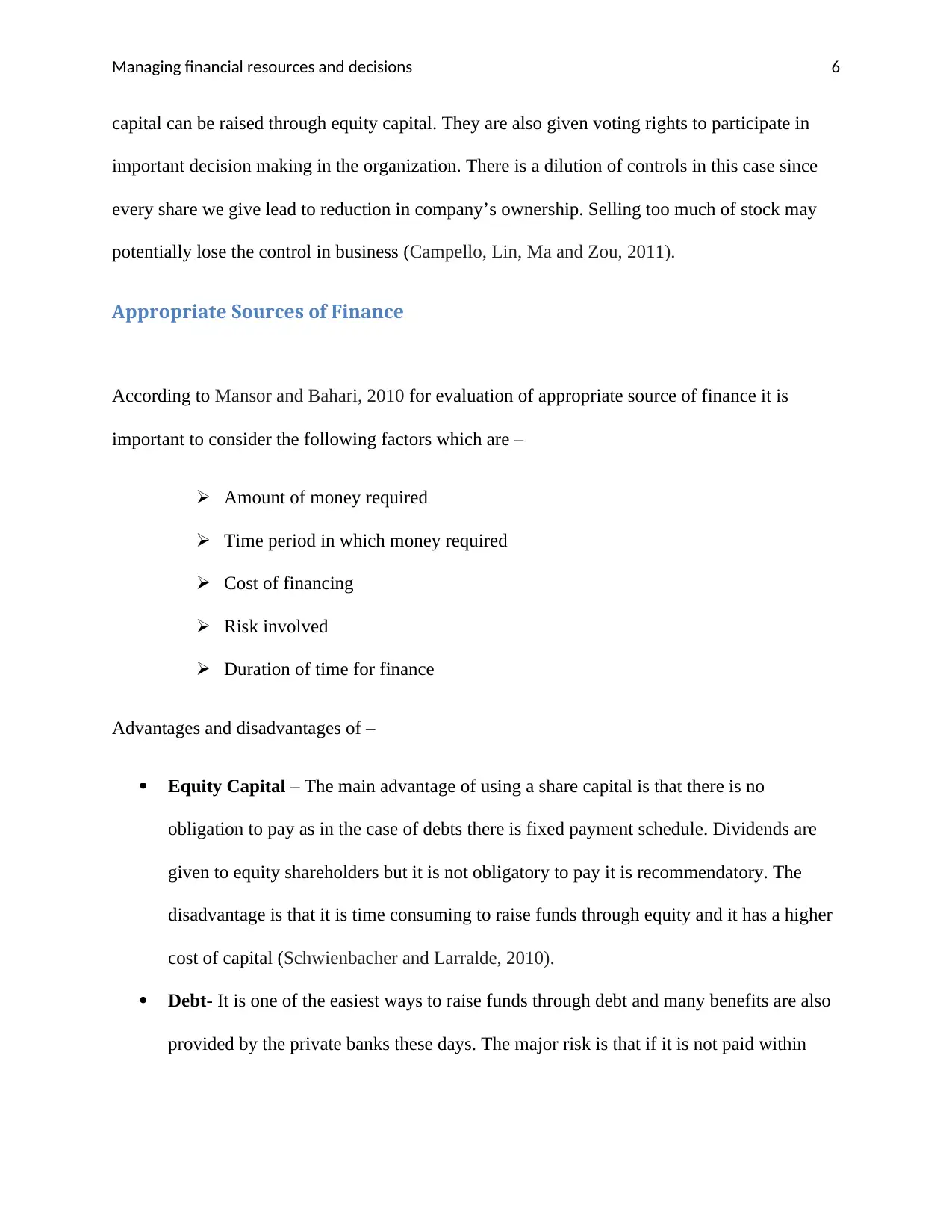
Managing financial resources and decisions 6
capital can be raised through equity capital. They are also given voting rights to participate in
important decision making in the organization. There is a dilution of controls in this case since
every share we give lead to reduction in company’s ownership. Selling too much of stock may
potentially lose the control in business (Campello, Lin, Ma and Zou, 2011).
Appropriate Sources of Finance
According to Mansor and Bahari, 2010 for evaluation of appropriate source of finance it is
important to consider the following factors which are –
Amount of money required
Time period in which money required
Cost of financing
Risk involved
Duration of time for finance
Advantages and disadvantages of –
Equity Capital – The main advantage of using a share capital is that there is no
obligation to pay as in the case of debts there is fixed payment schedule. Dividends are
given to equity shareholders but it is not obligatory to pay it is recommendatory. The
disadvantage is that it is time consuming to raise funds through equity and it has a higher
cost of capital (Schwienbacher and Larralde, 2010).
Debt- It is one of the easiest ways to raise funds through debt and many benefits are also
provided by the private banks these days. The major risk is that if it is not paid within
capital can be raised through equity capital. They are also given voting rights to participate in
important decision making in the organization. There is a dilution of controls in this case since
every share we give lead to reduction in company’s ownership. Selling too much of stock may
potentially lose the control in business (Campello, Lin, Ma and Zou, 2011).
Appropriate Sources of Finance
According to Mansor and Bahari, 2010 for evaluation of appropriate source of finance it is
important to consider the following factors which are –
Amount of money required
Time period in which money required
Cost of financing
Risk involved
Duration of time for finance
Advantages and disadvantages of –
Equity Capital – The main advantage of using a share capital is that there is no
obligation to pay as in the case of debts there is fixed payment schedule. Dividends are
given to equity shareholders but it is not obligatory to pay it is recommendatory. The
disadvantage is that it is time consuming to raise funds through equity and it has a higher
cost of capital (Schwienbacher and Larralde, 2010).
Debt- It is one of the easiest ways to raise funds through debt and many benefits are also
provided by the private banks these days. The major risk is that if it is not paid within
Paraphrase This Document
Need a fresh take? Get an instant paraphrase of this document with our AI Paraphraser
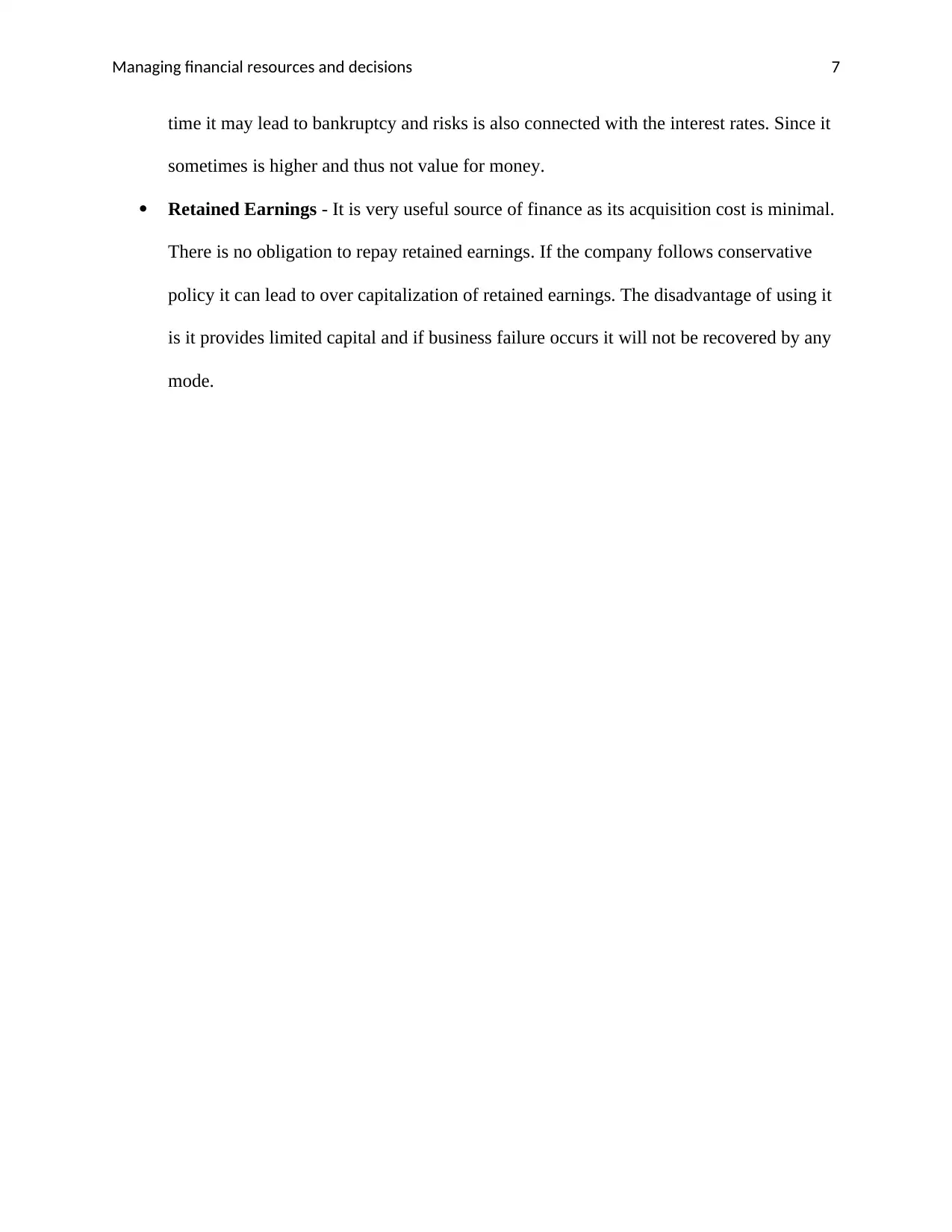
Managing financial resources and decisions 7
time it may lead to bankruptcy and risks is also connected with the interest rates. Since it
sometimes is higher and thus not value for money.
Retained Earnings - It is very useful source of finance as its acquisition cost is minimal.
There is no obligation to repay retained earnings. If the company follows conservative
policy it can lead to over capitalization of retained earnings. The disadvantage of using it
is it provides limited capital and if business failure occurs it will not be recovered by any
mode.
time it may lead to bankruptcy and risks is also connected with the interest rates. Since it
sometimes is higher and thus not value for money.
Retained Earnings - It is very useful source of finance as its acquisition cost is minimal.
There is no obligation to repay retained earnings. If the company follows conservative
policy it can lead to over capitalization of retained earnings. The disadvantage of using it
is it provides limited capital and if business failure occurs it will not be recovered by any
mode.
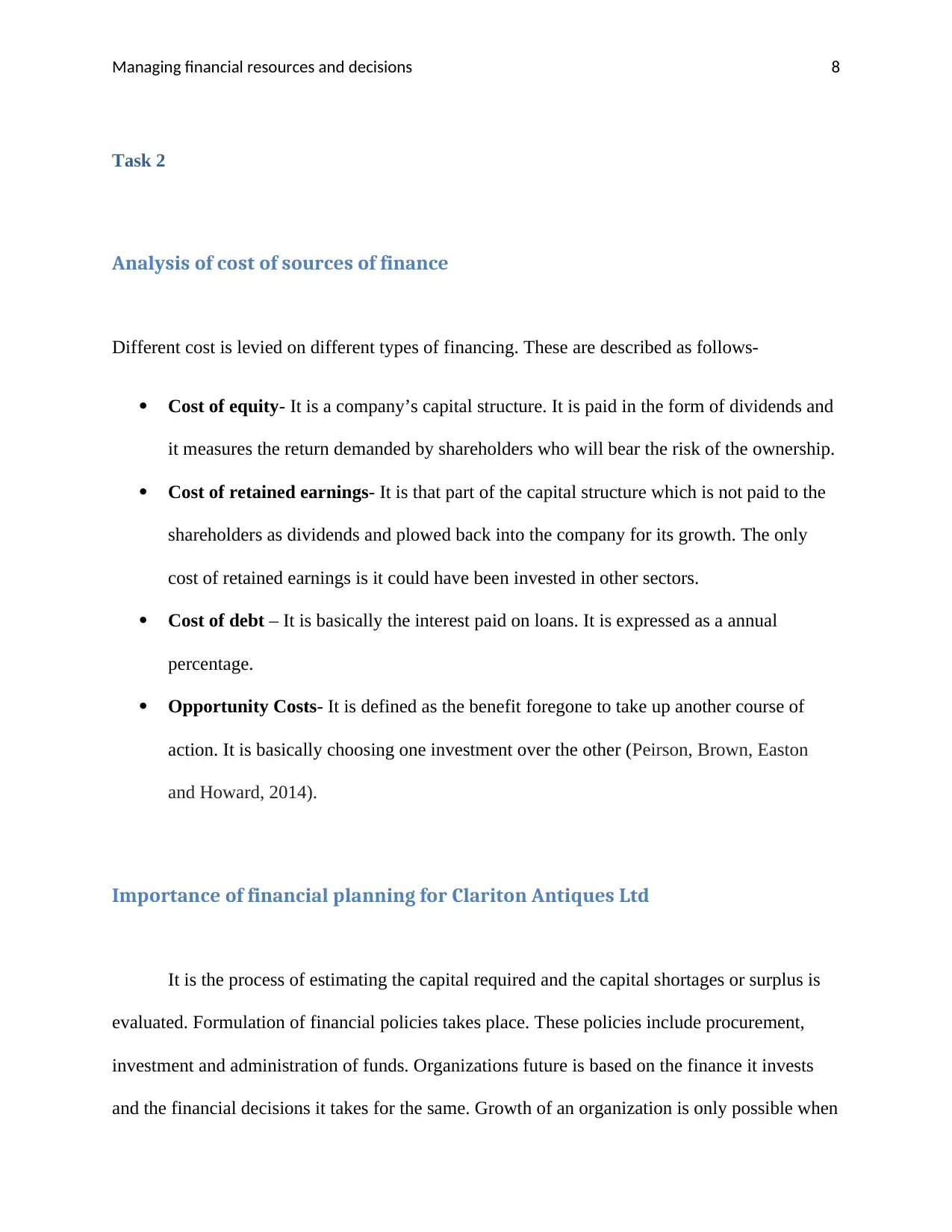
Managing financial resources and decisions 8
Task 2
Analysis of cost of sources of finance
Different cost is levied on different types of financing. These are described as follows-
Cost of equity- It is a company’s capital structure. It is paid in the form of dividends and
it measures the return demanded by shareholders who will bear the risk of the ownership.
Cost of retained earnings- It is that part of the capital structure which is not paid to the
shareholders as dividends and plowed back into the company for its growth. The only
cost of retained earnings is it could have been invested in other sectors.
Cost of debt – It is basically the interest paid on loans. It is expressed as a annual
percentage.
Opportunity Costs- It is defined as the benefit foregone to take up another course of
action. It is basically choosing one investment over the other (Peirson, Brown, Easton
and Howard, 2014).
Importance of financial planning for Clariton Antiques Ltd
It is the process of estimating the capital required and the capital shortages or surplus is
evaluated. Formulation of financial policies takes place. These policies include procurement,
investment and administration of funds. Organizations future is based on the finance it invests
and the financial decisions it takes for the same. Growth of an organization is only possible when
Task 2
Analysis of cost of sources of finance
Different cost is levied on different types of financing. These are described as follows-
Cost of equity- It is a company’s capital structure. It is paid in the form of dividends and
it measures the return demanded by shareholders who will bear the risk of the ownership.
Cost of retained earnings- It is that part of the capital structure which is not paid to the
shareholders as dividends and plowed back into the company for its growth. The only
cost of retained earnings is it could have been invested in other sectors.
Cost of debt – It is basically the interest paid on loans. It is expressed as a annual
percentage.
Opportunity Costs- It is defined as the benefit foregone to take up another course of
action. It is basically choosing one investment over the other (Peirson, Brown, Easton
and Howard, 2014).
Importance of financial planning for Clariton Antiques Ltd
It is the process of estimating the capital required and the capital shortages or surplus is
evaluated. Formulation of financial policies takes place. These policies include procurement,
investment and administration of funds. Organizations future is based on the finance it invests
and the financial decisions it takes for the same. Growth of an organization is only possible when
⊘ This is a preview!⊘
Do you want full access?
Subscribe today to unlock all pages.

Trusted by 1+ million students worldwide
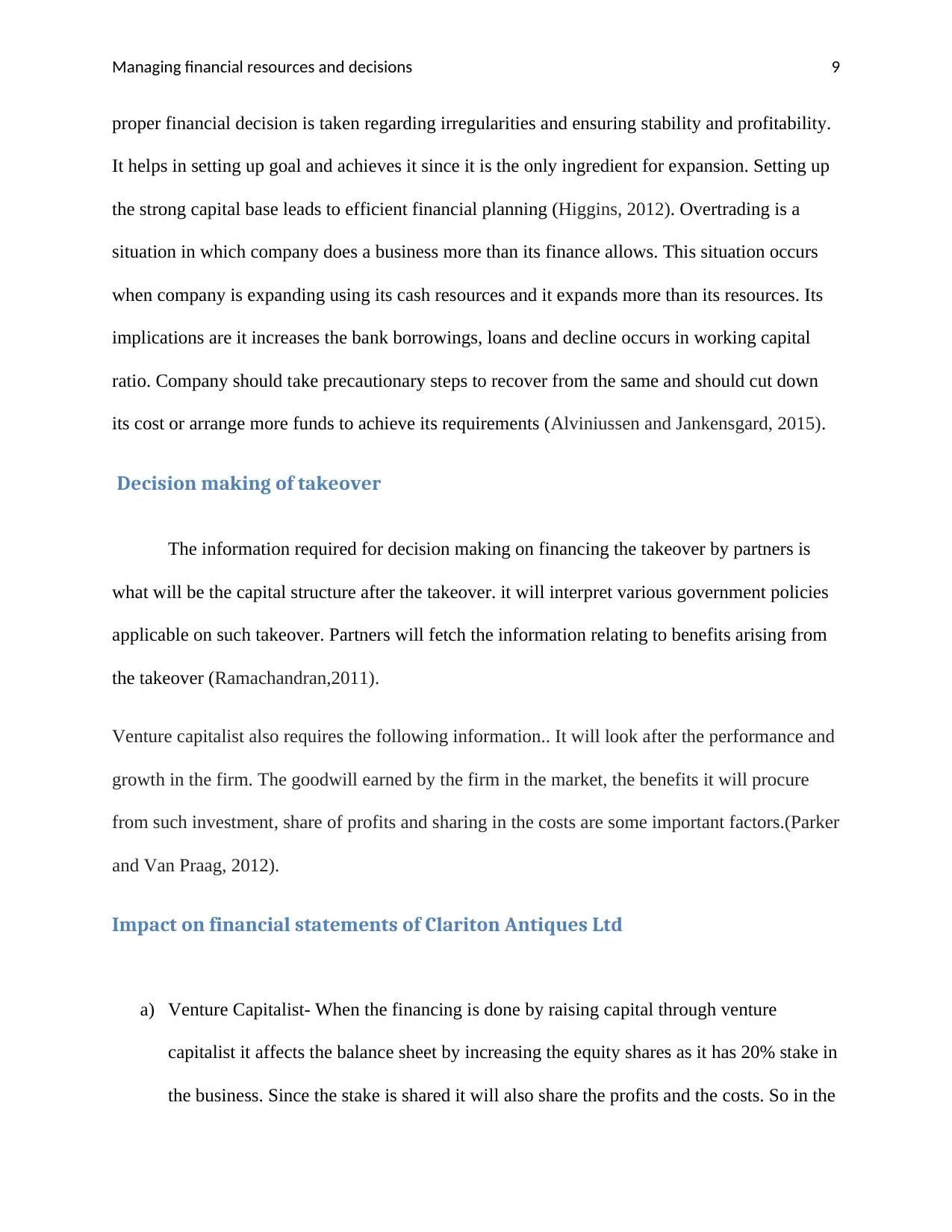
Managing financial resources and decisions 9
proper financial decision is taken regarding irregularities and ensuring stability and profitability.
It helps in setting up goal and achieves it since it is the only ingredient for expansion. Setting up
the strong capital base leads to efficient financial planning (Higgins, 2012). Overtrading is a
situation in which company does a business more than its finance allows. This situation occurs
when company is expanding using its cash resources and it expands more than its resources. Its
implications are it increases the bank borrowings, loans and decline occurs in working capital
ratio. Company should take precautionary steps to recover from the same and should cut down
its cost or arrange more funds to achieve its requirements (Alviniussen and Jankensgard, 2015).
Decision making of takeover
The information required for decision making on financing the takeover by partners is
what will be the capital structure after the takeover. it will interpret various government policies
applicable on such takeover. Partners will fetch the information relating to benefits arising from
the takeover (Ramachandran,2011).
Venture capitalist also requires the following information.. It will look after the performance and
growth in the firm. The goodwill earned by the firm in the market, the benefits it will procure
from such investment, share of profits and sharing in the costs are some important factors.(Parker
and Van Praag, 2012).
Impact on financial statements of Clariton Antiques Ltd
a) Venture Capitalist- When the financing is done by raising capital through venture
capitalist it affects the balance sheet by increasing the equity shares as it has 20% stake in
the business. Since the stake is shared it will also share the profits and the costs. So in the
proper financial decision is taken regarding irregularities and ensuring stability and profitability.
It helps in setting up goal and achieves it since it is the only ingredient for expansion. Setting up
the strong capital base leads to efficient financial planning (Higgins, 2012). Overtrading is a
situation in which company does a business more than its finance allows. This situation occurs
when company is expanding using its cash resources and it expands more than its resources. Its
implications are it increases the bank borrowings, loans and decline occurs in working capital
ratio. Company should take precautionary steps to recover from the same and should cut down
its cost or arrange more funds to achieve its requirements (Alviniussen and Jankensgard, 2015).
Decision making of takeover
The information required for decision making on financing the takeover by partners is
what will be the capital structure after the takeover. it will interpret various government policies
applicable on such takeover. Partners will fetch the information relating to benefits arising from
the takeover (Ramachandran,2011).
Venture capitalist also requires the following information.. It will look after the performance and
growth in the firm. The goodwill earned by the firm in the market, the benefits it will procure
from such investment, share of profits and sharing in the costs are some important factors.(Parker
and Van Praag, 2012).
Impact on financial statements of Clariton Antiques Ltd
a) Venture Capitalist- When the financing is done by raising capital through venture
capitalist it affects the balance sheet by increasing the equity shares as it has 20% stake in
the business. Since the stake is shared it will also share the profits and the costs. So in the
Paraphrase This Document
Need a fresh take? Get an instant paraphrase of this document with our AI Paraphraser
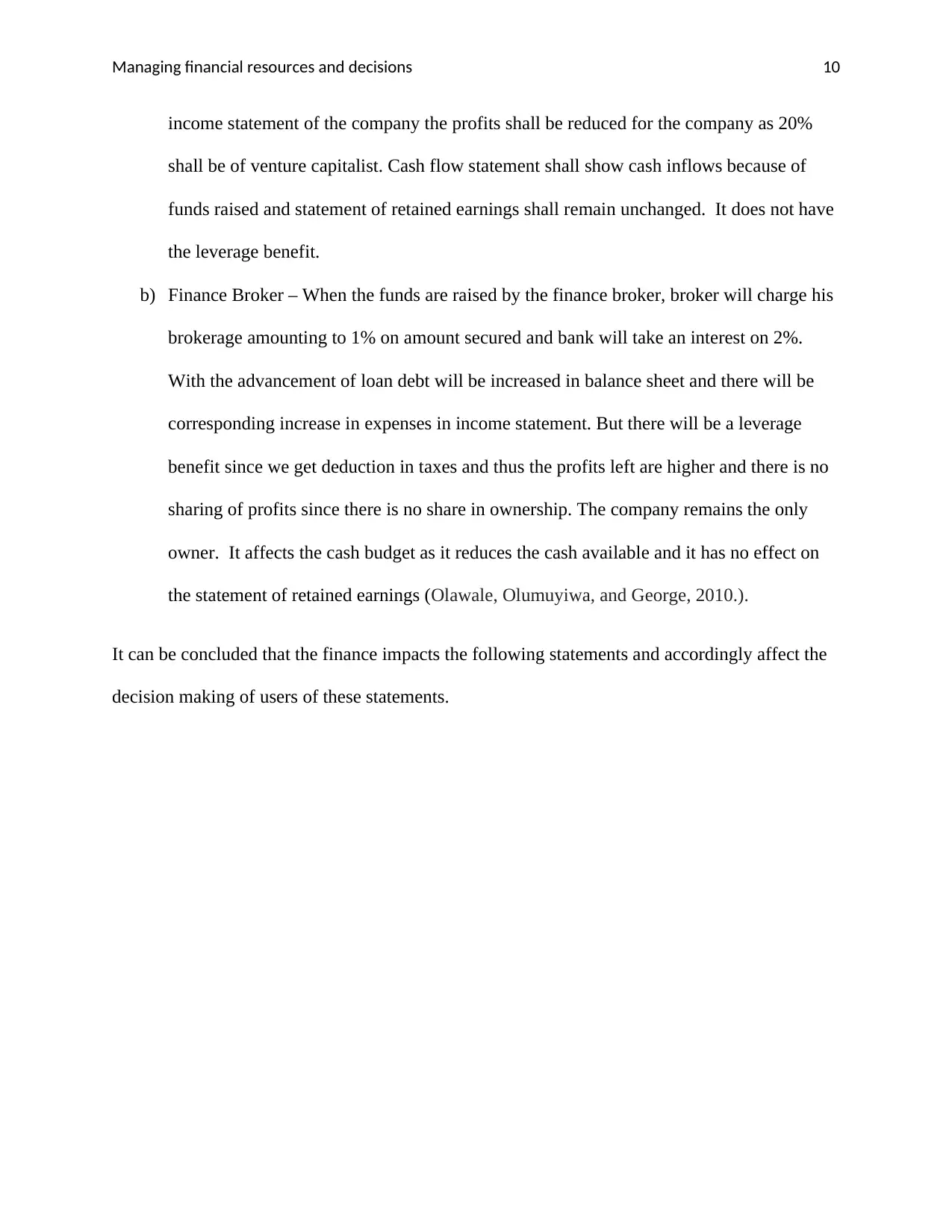
Managing financial resources and decisions 10
income statement of the company the profits shall be reduced for the company as 20%
shall be of venture capitalist. Cash flow statement shall show cash inflows because of
funds raised and statement of retained earnings shall remain unchanged. It does not have
the leverage benefit.
b) Finance Broker – When the funds are raised by the finance broker, broker will charge his
brokerage amounting to 1% on amount secured and bank will take an interest on 2%.
With the advancement of loan debt will be increased in balance sheet and there will be
corresponding increase in expenses in income statement. But there will be a leverage
benefit since we get deduction in taxes and thus the profits left are higher and there is no
sharing of profits since there is no share in ownership. The company remains the only
owner. It affects the cash budget as it reduces the cash available and it has no effect on
the statement of retained earnings (Olawale, Olumuyiwa, and George, 2010.).
It can be concluded that the finance impacts the following statements and accordingly affect the
decision making of users of these statements.
income statement of the company the profits shall be reduced for the company as 20%
shall be of venture capitalist. Cash flow statement shall show cash inflows because of
funds raised and statement of retained earnings shall remain unchanged. It does not have
the leverage benefit.
b) Finance Broker – When the funds are raised by the finance broker, broker will charge his
brokerage amounting to 1% on amount secured and bank will take an interest on 2%.
With the advancement of loan debt will be increased in balance sheet and there will be
corresponding increase in expenses in income statement. But there will be a leverage
benefit since we get deduction in taxes and thus the profits left are higher and there is no
sharing of profits since there is no share in ownership. The company remains the only
owner. It affects the cash budget as it reduces the cash available and it has no effect on
the statement of retained earnings (Olawale, Olumuyiwa, and George, 2010.).
It can be concluded that the finance impacts the following statements and accordingly affect the
decision making of users of these statements.
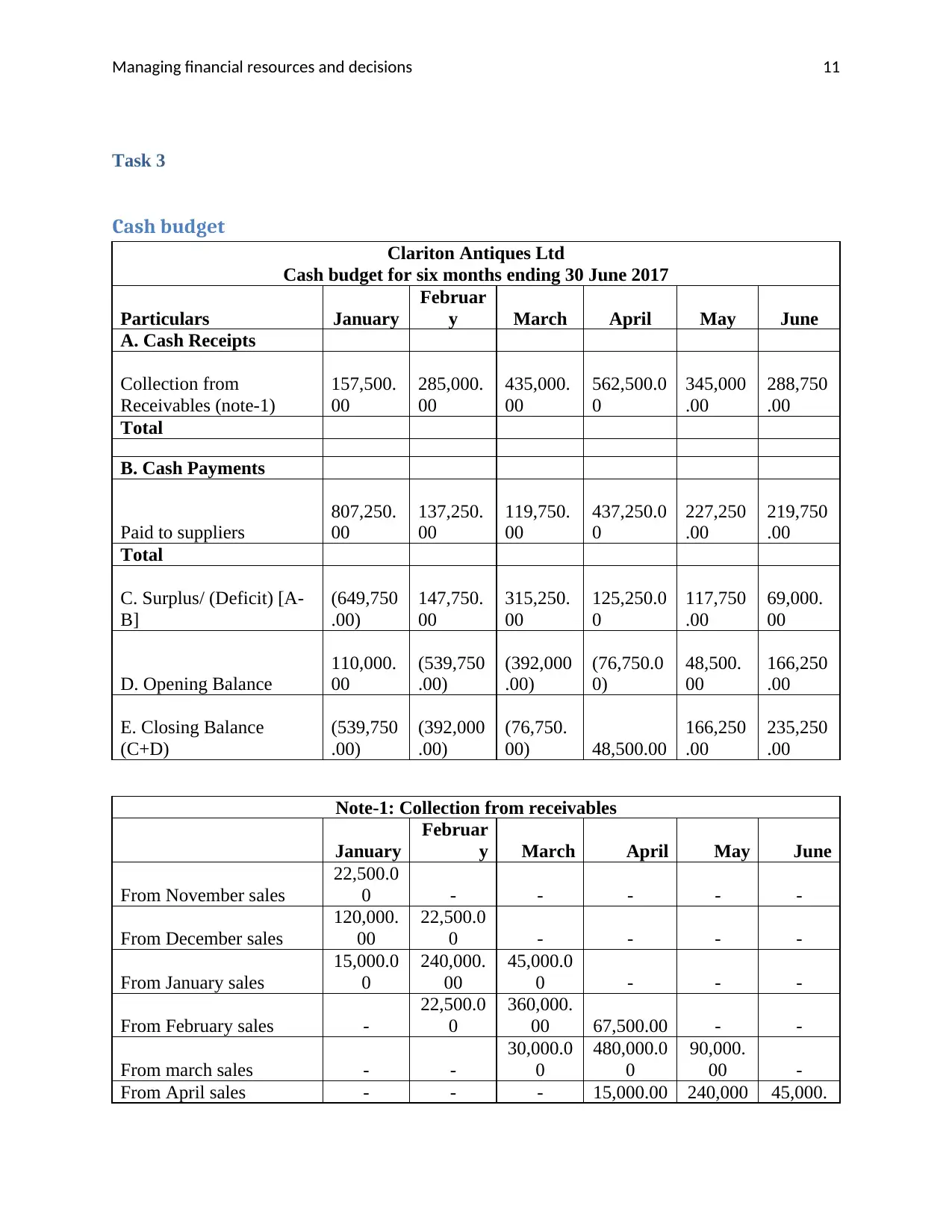
Managing financial resources and decisions 11
Task 3
Cash budget
Clariton Antiques Ltd
Cash budget for six months ending 30 June 2017
Particulars January
Februar
y March April May June
A. Cash Receipts
Collection from
Receivables (note-1)
157,500.
00
285,000.
00
435,000.
00
562,500.0
0
345,000
.00
288,750
.00
Total
B. Cash Payments
Paid to suppliers
807,250.
00
137,250.
00
119,750.
00
437,250.0
0
227,250
.00
219,750
.00
Total
C. Surplus/ (Deficit) [A-
B]
(649,750
.00)
147,750.
00
315,250.
00
125,250.0
0
117,750
.00
69,000.
00
D. Opening Balance
110,000.
00
(539,750
.00)
(392,000
.00)
(76,750.0
0)
48,500.
00
166,250
.00
E. Closing Balance
(C+D)
(539,750
.00)
(392,000
.00)
(76,750.
00) 48,500.00
166,250
.00
235,250
.00
Note-1: Collection from receivables
January
Februar
y March April May June
From November sales
22,500.0
0 - - - - -
From December sales
120,000.
00
22,500.0
0 - - - -
From January sales
15,000.0
0
240,000.
00
45,000.0
0 - - -
From February sales -
22,500.0
0
360,000.
00 67,500.00 - -
From march sales - -
30,000.0
0
480,000.0
0
90,000.
00 -
From April sales - - - 15,000.00 240,000 45,000.
Task 3
Cash budget
Clariton Antiques Ltd
Cash budget for six months ending 30 June 2017
Particulars January
Februar
y March April May June
A. Cash Receipts
Collection from
Receivables (note-1)
157,500.
00
285,000.
00
435,000.
00
562,500.0
0
345,000
.00
288,750
.00
Total
B. Cash Payments
Paid to suppliers
807,250.
00
137,250.
00
119,750.
00
437,250.0
0
227,250
.00
219,750
.00
Total
C. Surplus/ (Deficit) [A-
B]
(649,750
.00)
147,750.
00
315,250.
00
125,250.0
0
117,750
.00
69,000.
00
D. Opening Balance
110,000.
00
(539,750
.00)
(392,000
.00)
(76,750.0
0)
48,500.
00
166,250
.00
E. Closing Balance
(C+D)
(539,750
.00)
(392,000
.00)
(76,750.
00) 48,500.00
166,250
.00
235,250
.00
Note-1: Collection from receivables
January
Februar
y March April May June
From November sales
22,500.0
0 - - - - -
From December sales
120,000.
00
22,500.0
0 - - - -
From January sales
15,000.0
0
240,000.
00
45,000.0
0 - - -
From February sales -
22,500.0
0
360,000.
00 67,500.00 - -
From march sales - -
30,000.0
0
480,000.0
0
90,000.
00 -
From April sales - - - 15,000.00 240,000 45,000.
⊘ This is a preview!⊘
Do you want full access?
Subscribe today to unlock all pages.

Trusted by 1+ million students worldwide
1 out of 25
Related Documents
Your All-in-One AI-Powered Toolkit for Academic Success.
+13062052269
info@desklib.com
Available 24*7 on WhatsApp / Email
![[object Object]](/_next/static/media/star-bottom.7253800d.svg)
Unlock your academic potential
Copyright © 2020–2025 A2Z Services. All Rights Reserved. Developed and managed by ZUCOL.





